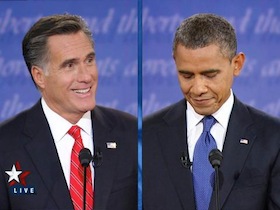Psychology prof studies what’s behind candidates’ smiles
As she was watching the first presidential debate, psychology Professor Paula Niedenthal couldn’t help but notice something odd about Barack Obama’s smile.
“He was looking down, tucking his chin, and smiling this tight, controlled smile,” says Niedenthal. “I would call it a ‘masking smile, concealing outrage or disdain.'”

Psychology Professor Paula Niedenthal is using video clips from the first presidential debate to study the meaning of the candidates’ smiles.
Mitt Romney, on the other hand, wore a “threat grin.”
“His smile was real, but it was not coming from a nice place,” Niedenthal says.
An expert on emotions, Niedenthal has studied and written about what facial expressions reveal (or conceal) about our feelings. She is particularly interested in smiles, because humans react so strongly to them. Turns out we mirror the emotions being sent through someone else’s smile. Whether the effect is positive (spreading like sunshine) or negative (spreading like a virus), one thing is certain: it’s contagious.
Niedenthal’s observations led to a new experiment in her lab.
“We are extracting clips of all of the smiles seen in the first presidential and vice presidential debates. We’ll run those through facial recognition software to test predictions of our model of how people perceive smiles,” she says. “It’ll also tell us something more objective about what the candidates were doing with their faces!”
Niedenthal and her students will also be looking at which muscles are actually involved in smiles displayed under different situations.
From “service with a smile,” to “let a smile be your umbrella,” people are urged to try smiling at school, at work, and especially in politics, to help them achieve success. But, says Niedenthal, we all know some smiles are anything but friendly.
By studying the subtle clues that determine whether a smile is genuine or fake, nice or nasty, Niedenthal hopes to build greater understanding of why, and how, smiles are so powerful.
Research shows that teeth send a signal. An open, toothy grin with raised chin and direct eye contact — like Joe Biden’s — can indicate aggression and a desire for dominance. When people smile while drawing the tops of their eyebrows together, as Paul Ryan sometimes does (and former President Bill Clinton did on at least one noteworthy occasion), this may indicate that they are lying.
“I didn’t see a victor of nasty expressions,” Niedenthal says, thinking back over the Biden-Ryan debate. “They both were doing it. But they have different faces — Biden’s may have been more memorable.”
While the news media are buzzing about the candidates’ nonverbal behavior — from criticisms of “alpha-male” strutting to charges of contemptuous laughter — Niedenthal doesn’t think the gesturing and posturing say much, necessarily, about their ability to lead.
“People have to decide whether a smile is appropriate to the context. In a one-on-one debate, when candidates are pitted against one another, you’re going to see aggression, disdain, all of it,” says Niedenthal. But in the later debates, the smiles become much more automatic and genuine, because they’re not looking at each other, they’re looking at the audience,” she said.
How those smiles play out on an international stage is the bigger question, she said.
—Mary Ellen Gabriel




